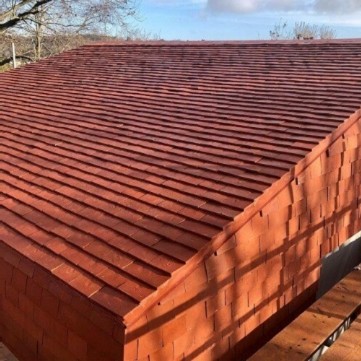Traditional clay tiles in Cambridgeshire
Heritage Tiles: Emblematic of the finest craftsmanship
Heritage tiles are the professional roofer's choice for the highest quality clay roof tiles. We pride ourselves in manufacturing, stocking, and delivering the very finest in prestige clay roof tiles.
Heritage Tiles have several tile ranges that satisfy every architectural requirement. Vintage and historic properties right up to modern new builds are covered by the diverse range of clay roof tiles that we stock.
So, whether you are in the building trade, or simply wish to choose your own tiles, Heritage Tiles have the right product for your specific requirements.
What Heritage Tiles have to offer our customers?
- We offer specification and technical solutions to help you achieve the perfect build.
- We also offer expert design advice to all our customers.
- We are happy to engage in site visits with our clients.
- We have stockists and distributors throughout the United Kingdom to ensure that we can provide our expert service to a wider area.
- We can provide estimated quantities from plans supplied by our clients.
- We offer battening plans.
- We can deliver a standard and bespoke colour choice for our clay tile products.
- All our tiles are assessed and approved by Lucideon.
- We provide a nationwide delivery and collection service.
The ranges of clay roof tiles we supply.
The Clayhall Range of roof tiles:

Clayhall Medium Blend - Carefully crafted to replicate all the features of handmade the Clayhall hand crafted range of tiles offers an excellent alternative when budget restrictions are a concern, but without compromising quality or durability.
Clayhall Dark Blend - Quality and durability in a budget clay roof tile. The Clayhall dark blend is sure to turn heads.
Clayhall Red Blend - A beautiful rustic clay roof tile. The Clayhall red blend is a firm favourite with our customers.
Clayhall Hamlet Mix - The Clayhall Hamlet mix is a gorgeous light and sandy looking clay roof tile that is a perennial favourite in the building trade.
Clayhall Birchwood Mix - The Clayhall Birchwood mix offers a gorgeous blend of lighter and darker shades in this diverse clay roof tile. If you are concerned that your roof tiles could look monotonous, the Clayhall Birchwood mix is the clay roof tile to choose.
The Conservation Range of roof tiles

The Conservation range of roof tiles are available in a range of distinctive colours, created by using a very fine sand, The Conservation Weathered; A natural warm tone, achieving an instant mellow and settled look and The Conservation Red; perfect for vertical tiling especially suited for villages and hamlets with olde world vernacular charm.
Manufactured using high quality clay, achieving high strength and durability properties, giving homeowners and contractors peace of mind for many years to come. The conservation range comes with a complete set of associated fittings, including Hog Back Ridge, Half Round Ridge, Bonnet Hips, Valley tiles and External Angles.
The Conservation range of clay roof tiles comes in the following variations:
- Conservation Red
- Conservation Weathered
- Conservation Dark
Conservation Peg Tile
Plain clay roofing tiles laid to a double lap have been used for roof covering in England since before the Norman Conquest and tiles dating back to Roman Times have been discovered under excavation. From the outset clay plain tiles were made incorporating fixing features.
The Classic Edwardian roof tile
The Classic range of plain tiles is one of the finest ranges of clay tiles.
We source only the best raw materials for our craftsman to create beautifully handmade clay tiles of the highest quality and durability.
Tile Fittings available from Heritage Tiles
There are many fittings that are available from us a Heritage Tiles to complete your build to perfection. We stock and supply the following:
- Gable Tile
- Eave Tile
- Baby Porch Ridge
- 90 Degree Ext. Angle
- Universal Bonnet Hip
- Half Round Ridge
- Hogs Back Ridge
- Mono Ridge
- Third Round Ridge
- Universal Valley
- Ornamental Club
- Bat Tile Set
Bat Tiles:
Provide help for our bats with our range of bat friendly roof tiles.
Did you know that all UK bats and their roosts are protected by law? The Wildlife and Countryside Act introduced in 1981, gave legal protection to all bat species and their roosts in England.
Distinct species of bats prefer differing places to roost. The two most usually found species of bat in the UK are the Pipistrelle and Brown Long-Eared Bat. Pipistrelle prefer confined spaces such as under tiles on roofs and hanging spaces. The Brown Long-Eared Bat prefer roof timbers and ridges inside lofts. Heritage Clay Tiles can provide purpose made access points within your roof tiles or ridge tiles. The Bat Tile Set can form part of a mitigation package required by law for existing roosts or as potential access where a roost had not previously been present.
Select a Blend
Getting the right blend for your roofing project can feel daunting, but with our blend generator you can mix and match various blends of tiles to achieve the perfect blend.
Click here to make use of our online tool to choose your own unique blend.
Because our strict quality control provides a consistent tile size you can mix assorted styles and colours of tiles to make your roof unique to you. Please use the tool below to experiment with various blends.
Adjust the sliders to set the ingredients for your desired blend then click on the update mix button.
Alternatively click on any blend or tile to display it.
Whatever type of clay roof tile you want, Heritage Tiles will be able to help.
Traditional clay tiles
Traditional clay tiles: Born of fire!
Traditional clay tiles have been the standard roofing material for many hundreds of years in the United Kingdom.
In fact, traditional clay tiles were rapidly adopted following a disastrous fire in Southwark in 1212. Following the fire, King John made a proclamation, stating that buildings in London should be built with traditional clay tiles, rather than thatched roofing, since they were more resistant to fire. Traditional clay tiles are actually given life by fire! They achieve their strength, durability, colour and texture in the kiln, so it's only natural that they are such a sought after roofing material.
Traditional clay tiles are still extensively used today and relied on for their aesthetics and performance as a superior roofing material. Certain manufacturing techniques have developed over the years, but the traditional clay tiles still leave the manufacturer after being crafted in the time honoured way.
So how are Heritage Clay Tiles Ltd clay roof tiles made today?
Throughout history clay tiles have traditionally been formed by hand, then textured or glazed with colour and fired in high-temperature kilns to set. These traditional clay tiles remain the most sought after tiles on the market today.
The manufacturing process of traditional clay tiles is still very similar today, handcrafted clay tiles are still available and often the tile of choice for heritage projects, however, you can also purchase machine-made clay tiles created to imitate the appearance of traditional clay tiles.
There are regional differences in traditional clay tiles
Regional differences in traditional clay tiles occur due to localised sourcing of the basic clay material, which means it is different across each region, these differences become more obvious once the clay is fired in a kiln which leads to variations in colour and textures, unique to each region. The geological make up of the ground clay will have a major impact on the finished traditional clay tiles.
Not only does the type of clay differ region to region, there are also localised preferences in the popularity of different roof profiles, colours and textures. The South-East tends to prefer the red traditional clay tiles over the more modern alternatives.
Modern Roman roof tiles, refers to tiles that have a flat shape with one or two rolls, or curves; these are known as single or double Romans. These types of clay roof tiles remain popular in the South West of England.
Plain tiles which are flat in appearance and more traditionally likened to the original Roman clay tile remain a popular choice in London and the South of England. Larger traditional clay tiles tend to be more popular in the North of the United Kingdom.
How traditional clay tiles are made today
The process is still very similar to that of the old and more traditional manufacturing techniques, but this is done on a much larger scale. The tiles are created by filling tile moulds or pallets with wet clay and baking these at a very high temperature in a kiln. The weight and feel of the tile is determined by how long it is baked for and at what temperature. Clay roof tiles come in a variety of finishes and colours; a traditional terracotta finish remains the most popular for any clay roof tile.
A little information about Cambridgeshire
Folk music for Cambridgeshire
The Cambridge Folk Festival is a highpoint for folk music enthusiasts from in and around the Cambridgeshire area. The festival is held every year, but first opened in 1965. This popular music event is held on the site of Cherry Hinton Hall in Cherry Hinton, one of the villages subsumed by the city of Cambridge. The festival is known for its fantastic mix of music and a pretty wide definition of what might be considered actual folk music. It occurs over a long Bank Holiday weekend in summer. Until 2008 it was sponsored by BBC Radio 2, who broadcast it live, with highlights that were recorded and shown later and occasionally live on digital television channels. BBC Four broadcast the Cambridgeshire event from 2002 to 2009 and from 2010 to 2012 the festival was moved to Sky Arts.
History of the Cambridgeshire music festival
Recent events have obscured the early origins of the Cambridge folk festival. In 1974 the Cambridge Folk Festival was described as an event that was born after three Cambridgeshire councillors who had an idea for a festival. The key figures responsible for setting up and founding the Cambridge Folk festival are named as Paul Rayment, Philip Abrams and George Scurfield.
The setting up of the Cambridgeshire musical event took about nine months and was developed by Paul Rayment, Philip Abrams and George Scurfield before Ken Woollard was asked to run the festival. In the 1960s the Rayments, Sharkeys, Scurfields and Woollards were all associated with Cambridge Labour Party and the folk club to greater or lesser extents. Jack Sharkey had the original idea which may have been linked to Jazz on a Summers Day, the documentary film set at the 1958 Newport Jazz Festival in Rhode Island, and he involved Paul Rayment. Jack Sharkey also had the idea to hold the festival at Cherry Hinton Hall, and his engagement with folk music was instrumental to the original initiative.
It has been argued many times that Paul Rayments initiative, drive, commitment and political skill produced the Cambridgeshire folk festival. In his role as a councillor, he suggested the festival site of Cherry Hinton, managed the electrics of the first festival and volunteered to stay the night in the marquee for the first festival; there was no security. The other key figures who developed the festival were Philip Abrams, a professor of sociology who saw it as a social initiative, and George Scurfield, an author, poet, and politician, whose abilities and sense of adventure and were vital to the establishment of the festival. The 1965 festival was the fruit of a Labour controlled council in a traditionally conservative area and particularly the endeavours of Paul Rayment. The founding of the Cambridge Folk festival reflects its subsequent diversity when a war hero poet and politician worked with an eminent sociologist and a politically driven electrician to bring something together representative of the 1960s zeitgeist in Cambridge. This was then handed over and brought to fruition by Ken Woollard, a local firefighter and socialist political activist, to help organise it.
Big names at the Cambridgeshire festival
The first Cambridgeshire festival sold 1400 tickets and almost broke even. Squeezed in as a late addition to the bill was a young Paul Simon who had just released "I Am A Rock". The festivals popularity quickly grew from that moment on. Woollard continued as Festival organiser and artistic director up until his death in 1993. In 2014 the festival celebrated its 50th event, including artists such as Van Morrison and Sinead O'Connor. Until 2015 it was run by Cambridge City Council. It is now run by a charity called Cambridge Live.
Products available from Heritage Clay Tiles Ltd in East Sussex
Clay Roof Tiles in East Sussex
Clayhall Roof Tiles in East Sussex
Conservation Roof Tiles in East Sussex
Edwardian Roof Tiles in East Sussex
Victorian Roof Tiles in East Sussex
Georgian Roof Tiles in East Sussex
Handmade Clay Tiles in East Sussex
Handmade Roof Tiles in East Sussex
High Quality Roof Tiles in East Sussex
Traditional clay tiles in East Sussex
Traditional roof tiles in East Sussex
Products available from Heritage Clay Tiles Ltd in Essex
Conservation Roof Tiles in Essex
High Quality Roof Tiles in Essex
Traditional clay tiles in Essex
Traditional roof tiles in Essex
Products available from Heritage Clay Tiles Ltd in Hampshire
Clayhall Roof Tiles in Hampshire
Conservation Roof Tiles in Hampshire
Edwardian Roof Tiles in Hampshire
Victorian Roof Tiles in Hampshire
Georgian Roof Tiles in Hampshire
Handmade Clay Tiles in Hampshire
Handmade Roof Tiles in Hampshire
High Quality Roof Tiles in Hampshire
Traditional clay tiles in Hampshire
Traditional roof tiles in Hampshire
Products available from Heritage Clay Tiles Ltd in Hertfordshire
Clay Roof Tiles in Hertfordshire
Clayhall Roof Tiles in Hertfordshire
Conservation Roof Tiles in Hertfordshire
Edwardian Roof Tiles in Hertfordshire
Victorian Roof Tiles in Hertfordshire
Georgian Roof Tiles in Hertfordshire
Handmade Clay Tiles in Hertfordshire
Handmade Roof Tiles in Hertfordshire
High Quality Roof Tiles in Hertfordshire
Traditional clay tiles in Hertfordshire
Traditional roof tiles in Hertfordshire
Products available from Heritage Clay Tiles Ltd in Kent
Conservation Roof Tiles in Kent
High Quality Roof Tiles in Kent
Traditional clay tiles in Kent
Traditional roof tiles in Kent
Products available from Heritage Clay Tiles Ltd in London
Conservation Roof Tiles in London
Edwardian Roof Tiles in London
Victorian Roof Tiles in London
High Quality Roof Tiles in London
Traditional clay tiles in London
Traditional roof tiles in London
Products available from Heritage Clay Tiles Ltd in Surrey
Conservation Roof Tiles in Surrey
Edwardian Roof Tiles in Surrey
Victorian Roof Tiles in Surrey
High Quality Roof Tiles in Surrey
Traditional clay tiles in Surrey
Traditional roof tiles in Surrey
Products available from Heritage Clay Tiles Ltd in West Sussex
Clay Roof Tiles in West Sussex
Clayhall Roof Tiles in West Sussex
Conservation Roof Tiles in West Sussex
Edwardian Roof Tiles in West Sussex
Victorian Roof Tiles in West Sussex
Georgian Roof Tiles in West Sussex
Handmade Clay Tiles in West Sussex
Handmade Roof Tiles in West Sussex
High Quality Roof Tiles in West Sussex
Traditional clay tiles in West Sussex
Traditional roof tiles in West Sussex
Products available from Heritage Clay Tiles Ltd in Bedfordshire
Clay Roof Tiles in Bedfordshire
Clayhall Roof Tiles in Bedfordshire
Conservation Roof Tiles in Bedfordshire
Edwardian Roof Tiles in Bedfordshire
Victorian Roof Tiles in Bedfordshire
Georgian Roof Tiles in Bedfordshire
Handmade Clay Tiles in Bedfordshire
Handmade Roof Tiles in Bedfordshire
High Quality Roof Tiles in Bedfordshire
Traditional clay tiles in Bedfordshire
Traditional roof tiles in Bedfordshire
Products available from Heritage Clay Tiles Ltd in Berkshire
Clayhall Roof Tiles in Berkshire
Conservation Roof Tiles in Berkshire
Edwardian Roof Tiles in Berkshire
Victorian Roof Tiles in Berkshire
Georgian Roof Tiles in Berkshire
Handmade Clay Tiles in Berkshire
Handmade Roof Tiles in Berkshire
High Quality Roof Tiles in Berkshire
Traditional clay tiles in Berkshire
Traditional roof tiles in Berkshire
Products available from Heritage Clay Tiles Ltd in Buckinghamshire
Clay Roof Tiles in Buckinghamshire
Clayhall Roof Tiles in Buckinghamshire
Conservation Roof Tiles in Buckinghamshire
Edwardian Roof Tiles in Buckinghamshire
Victorian Roof Tiles in Buckinghamshire
Georgian Roof Tiles in Buckinghamshire
Handmade Clay Tiles in Buckinghamshire
Handmade Roof Tiles in Buckinghamshire
High Quality Roof Tiles in Buckinghamshire
Traditional clay tiles in Buckinghamshire
Traditional roof tiles in Buckinghamshire
Products available from Heritage Clay Tiles Ltd in Cambridgeshire
Clay Roof Tiles in Cambridgeshire
Clayhall Roof Tiles in Cambridgeshire
Conservation Roof Tiles in Cambridgeshire
Edwardian Roof Tiles in Cambridgeshire
Victorian Roof Tiles in Cambridgeshire
Georgian Roof Tiles in Cambridgeshire
Handmade Clay Tiles in Cambridgeshire
Handmade Roof Tiles in Cambridgeshire
High Quality Roof Tiles in Cambridgeshire
Traditional roof tiles in Cambridgeshire
Products available from Heritage Clay Tiles Ltd in Oxfordshire
Clay Roof Tiles in Oxfordshire
Clayhall Roof Tiles in Oxfordshire
Conservation Roof Tiles in Oxfordshire
Edwardian Roof Tiles in Oxfordshire
Victorian Roof Tiles in Oxfordshire
Georgian Roof Tiles in Oxfordshire
Handmade Clay Tiles in Oxfordshire
Handmade Roof Tiles in Oxfordshire
High Quality Roof Tiles in Oxfordshire
Traditional clay tiles in Oxfordshire
Traditional roof tiles in Oxfordshire
Products available from Heritage Clay Tiles Ltd in Suffolk
Clayhall Roof Tiles in Suffolk
Conservation Roof Tiles in Suffolk
Edwardian Roof Tiles in Suffolk
Victorian Roof Tiles in Suffolk
Georgian Roof Tiles in Suffolk
Handmade Clay Tiles in Suffolk
Handmade Roof Tiles in Suffolk
High Quality Roof Tiles in Suffolk
Traditional clay tiles in Suffolk
Traditional roof tiles in Suffolk
Further Information
If you would like to know more or are interested in a quote we would be happy to help. Phone us on 01634 471 344, email us at sales@heritagetiles.co.uk and we will be in touch as soon as possible.







